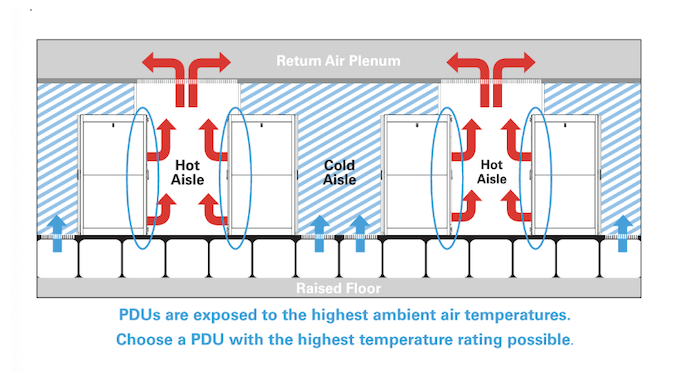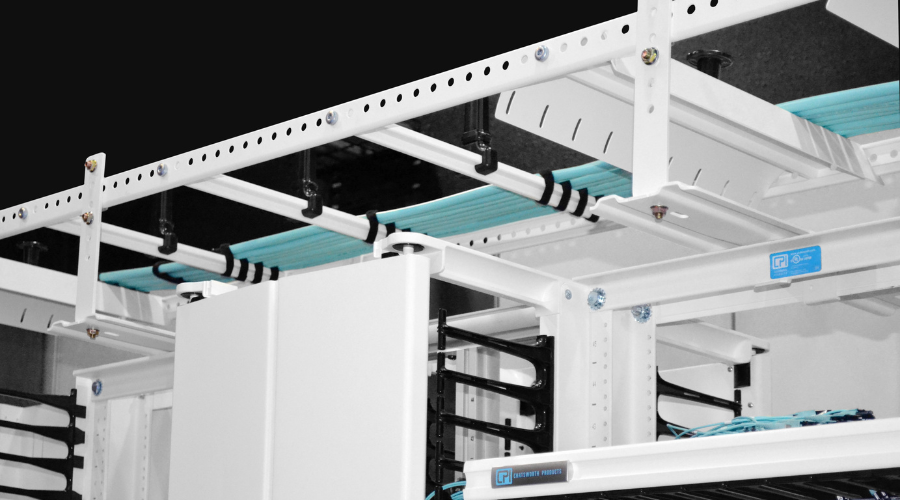
With power densities soaring and high-density applications becoming the new standard, data centers now face the challenge of managing massive power and heat loads. To maintain uninterrupted operations, the ability to scale power distribution with precision and efficiency is no longer optional—it's essential.
As data processing demands surge, investing in smarter, more robust power distribution units (PDUs) with advanced capabilities is a strategic necessity for businesses determined to stay ahead.
In this post, we’ll explore the different types of intelligent PDUs, their key benefits, and how metering levels play a vital role in enhancing overall power management, efficiency, and reliability.
What is an Intelligent PDU?
While basic PDUs provide simple power distribution and protection against overloads, intelligent PDUs have an embedded processor that controls and manages the advanced features like real-time monitoring, remote management, and analytics.
Additionally, many intelligent PDUs have field-replaceable modules, enabling users to easily swap out components like network controllers or monitoring modules without taking the entire PDU offline, ensuring continued operation with minimal disruption.
Beyond power distribution, intelligent PDUs often integrate environmental monitoring sensors, such as temperature and humidity, to help prevent overheating or other environmental risks in data centers.

Key Features of Intelligent PDUs:
Real-Time Monitoring and Management:
- Depending on functionality level, intelligent PDUs provide detailed, real-time monitoring of power parameters at the input, branch circuit and at the outlet level, enabling precise tracking and management. They track key metrics such as voltage, current, power consumption, and environmental conditions like temperature and humidity.
- They can be configured to send real-time alerts and notifications if power usage exceeds certain thresholds or if any irregularities are detected, enabling prompt corrective actions.
Remote Control
- Intelligent PDUs with outlet switching capabilities provide the ability to remotely reboot individual devices, schedule power cycling and turn outlets on or off.
Environmental Monitoring:
- Equipped with environmental sensors, intelligent PDUs continuously observe and record key environmental conditions within the cabinet, including temperature and humidity. By proactively monitoring these conditions, they promptly alert operators to potential issues such as overheating or abnormal humidity levels, eliminating the need for deploying a separate monitoring solution.
- Intelligent PDUs help ensure that liquid cooling systems are operating efficiently by providing real-time data on energy consumption and thermal performance, enabling precise adjustments to cooling strategies and avoiding energy waste.
Power Usage Analytics:
- They offer dashboards with detailed analytics and reporting on power consumption patterns. These analytics help identify inefficiencies, optimize energy use, and reduce costs. Additionally, they provide detailed logs and reports on power usage patterns, crucial for capacity planning, auditing, and compliance purposes.
High-Level Security:
- Intelligent PDUs support role-based cabinet level electronic access control, allowing administrators to assign varying levels of access and control to users based on their roles and responsibilities. This granular control ensures that only authorized personnel can perform specific actions. Furthermore, they ensure secure access through robust authentication, authorization, and encryption mechanisms, safeguarding sensitive data and critical infrastructure from potential breaches or attacks.
Integration with DCIM Systems:
- Data Center Infrastructure Management (DCIM) software provides the “single pane of glass” for monitoring all intelligent PDUs, environmental monitoring sensors and other facility sensors in the data center. You can monitor available rack, power and cooling capacity and identify areas for improvement. It can report at the device, rack, row, room or site level. Some DCIM software also include network mapping, power line mapping, asset management and/or predictive analytics capabilities.
Watch this video on how intelligent PDUs help with white space management:
Types of PDUs and Applications: From Basic to High-Density
With each progressive type of PDU, data center operators gain greater flexibility and insight into power management.
- Functionality: Basic PDUs provide straightforward power distribution and branch level overcurrent protection
- Application: Ideal for environments needing simple power distribution without the need for detailed monitoring or remote control.
- Price range: Starting at $447.70 MSRP.
- Functionality: Functions like a Basic PDU with a local meter, measuring power and local display of the power consumption of each connected device.
- Features: Typically monitors current draw on all input phases and may offer additional functionalities like temperature/humidity monitoring and remote accessibility. However, they lack the capability to directly monitor the status of devices connected to the PDU.
- Application: Beneficial when installation of new equipment is being done within the cabinet. Also, allows loads to be balanced when remote management of PDU's may not be an option.
- Price range: Starting at $600-800 MSRP.
- Functionality: Not only measures power consumption but also actively monitors the status of devices connected to the PDU. Monitored PDUs provide insights into power usage at the outlet level and can detect issues such as overheating or power surges. However, it cannot directly change anything – it can only observe.
- Features: Energy usage tracking, temperature/humidity monitoring, and remote accessibility. They provide outlet-level metering for precise power usage monitoring, allowing for proactive management and troubleshooting.
- Application: Useful for gaining detailed insights into power usage without needing remote control capabilities.
- Price range: $1,300 - $2,300 MSRP.
- Functionality: Switched PDUs monitor power with both eyes and hands. They allow remote action, so if you need to reboot a device or turn it off to save power, you can do it with on your computer or smartphone.
- Features: Outlet-level metering, individual outlet control, remote rebooting, power scheduling, and remote power management.
- Advanced Capabilities: Include a local interactive display for detailed power measurements and alarm listings, remote access via web browser, support for IPv6 and SNMP v3 protocols, and daisy chaining for managing multiple PDUs under one IP address.
- Application: Ideal for environments where remote power management is essential, providing both monitoring and control functionalities.
- Price: Starting at $2,400 MSRP.
Metering Levels: Functionality of Intelligent PDUs
Metering is a fundamental feature that distinguishes intelligent PDUs from basic PDUs. Metering comes in various types based on the required level of granularity and functionality. This chart below can help you make informed decisions when selecting intelligent PDUs.
Aggregate Metering:
- It collects overall power usage data without specifying individual outlets or circuits – like one big bucket collecting rainwater from the entire roof, providing a general picture of usage but lacking specific details.
- Typically found in all Monitored & Switched PDU's as well as Metered PDUs.
Outlet-Level Metering:
- Measures power usage at each outlet individually, like having several smaller buckets collecting rainwater from different areas of the roof. This helps identify usage patterns, detect leaks, and set baseline energy consumption for equipment.
- Commonly found in monitored PDUs.
Outlet-Level Switching:
- Allows remote control of individual outlets, enabling you to turn devices on or off from a distance. It's like having a switch for each bucket to control water flow. You can turn outlets on or off, reboot devices, or manage power distribution remotely, offering greater flexibility and control over power management.
- Found in Switched PDUs.
Branch Circuit Metering:
- Measures power usage for each branch circuit within the PDU, like having separate meters for different groups of outlets. This helps identify areas with higher power usage and balance the load across circuits more effectively.
- Often present in monitored or switched PDUs.
Three-Phase Power Metering:
- When three-phase power is used, this tracks power usage across the three separate streams of electricity, ensuring a balanced power distribution and efficient use of resources.
- Typically found in advanced PDUs for high-density environments where three-phase power is common.
Integrated Environmental Monitoring:
- Using attached to the PDU, this measures conditions like temperature and humidity, helping to maintain optimal conditions for IT equipment by providing early warnings of potential issues.
- Found in monitored or switched PDUs.

Find the Right PDU for You:
Top 5 Benefits of Intelligent PDUs for Data Centers
More Efficient Resource Allocation: With such detailed insight into power usage data, data center operators can identify underutilized equipment, consolidate workloads, and reallocate resources as needed. This helps you make smarter, quicker decisions about expansions and makes it easier to optimize space and airflow in your whitespace.
Increased Operational Reliability: The ability to monitor currents at all levels, set warning and critical thresholds, and receive notifications ensures a continuous power supply to critical devices, minimizing disruptions and downtime. Additionally, remote power recycling helps prevent downtime caused by unresponsive IT equipment.
Equipment Protection and Longevity: PDUs are often subjected to the highest ambient air temperatures in the data center as they are positioned at the back of the rack. Intelligent PDUs not only withstand higher heat loads but also actively manage them by promptly alerting operators to overheating devices or those consuming excessive power so they can remotely adjust settings, thereby protecting and extending the lifespan of equipment.

Energy Cost Savings and Support for Green Initiatives: By providing visibility into equipment level energy consumption, intelligent PDUs allow appropriate steps to be taken to lower energy costs, promote sustainable practices – helping data centers reduce their carbon footprints and mitigate environmental impact.
Reduced Monitoring and Reporting for Proof of SLAs and Metrics Intelligent PDUs can provide accurate and detailed power usage data for auditing and reporting purposes to help organizations demonstrate compliance with energy efficiency initiatives, environmental regulations, and corporate sustainability goals.
What sets CPI’s eConnect® Intelligent PDUs apart?
CPI’s eConnect® PDUs come in , from Basic to highly advanced Switched PDUs designed for reliable performance in high density environments.
- Market-leading ambient air temperature rating of 149°F (65°C).
- Over 160 standard configurations, including 100+ high-power options ranging up to 57.5kW per PDU to meet the needs of today’s most demanding data centers.
- Tool-less mounting and UL Listing for quick and easy installation.
- High customization capabilities, allowing you to tailor PDUs to your specific requirements.
- Pre-installation option into your data center cabinets, saving deployment time and reducing packaging waste.
- Comprehensive support backed by an excellent warranty, customer service, and how-to videos.
— a free and easy-to-use online tool that enables you to select the best power product for your application based on your requirements. After you’re done comparing, you can email or print the results.

